Numerical Simulation Study on Flow Heat Transfer and Stress Distribution of Shell-and-Tube Superheater in Molten Salt Solar Thermal Power Station
Abstract
:1. Introduction
2. Physical Model and Calculation Method
2.1. Physical Model
2.2. Calculation Method
df = ds
qf = qs
Tf = Ts
2.3. Discretization Method
2.4. Setting of Boundary Conditions
2.5. Accuracy Verification of the Model
3. Results and Discussion
3.1. Influence of Working Fluid Flow Position on Heat Exchange Efficiency and Stress Distribution Characteristics of Heat Exchanger
3.2. Influence of Inlet Temperature on Heat Exchange Efficiency and Stress Distribution Characteristics of Heat Exchanger
3.3. Influence of Inlet Flow Rate on Heat Exchange Efficiency and Stress Distribution Characteristics of Superheater
4. Conclusions
Author Contributions
Funding
Institutional Review Board Statement
Informed Consent Statement
Data Availability Statement
Conflicts of Interest
References
- Ouali, H.A.L.; Moussaoui, M.A.; Mezrhab, A.; Naji, H. Comparative Study Between Direct Steam Generation and Molten Salt Solar Tower Plants in the Climatic Conditions of the Eastern Moroccan Region. Int. J. Renew. Energy Dev. 2020, 9, 287–294. [Google Scholar] [CrossRef]
- Dong, X.; Bi, Q.; Yao, F. Experimental investigation on the heat transfer performance of molten salt flowing in an annular tube. Exp. Therm. Fluid Sci. 2019, 102, 113–122. [Google Scholar] [CrossRef]
- He, C.; Lu, J.; Ding, J.; Wang, W.; Yuan, Y. Heat transfer and thermal performance of two-stage molten salt steam generation system. Appl. Energy 2017, 204, 1231–1239. [Google Scholar] [CrossRef]
- Yuan, Y.; He, C.; Lu, J.; Ding, J. Thermal performances of molten salt steam generator. Appl. Therm. Eng. 2016, 105, 163–169. [Google Scholar] [CrossRef]
- Al-Kouz, W.; Almuhtady, A.; Abu-Libdeh, N.; Nayfeh, J.; Boretti, A. A 140 MW Solar Thermal Plant in Jordan. Processes 2020, 8, 668. [Google Scholar] [CrossRef]
- Rajeh, T.; Al-Kbodi, B.H.; Zhang, H.L. Thermal Stress and Deformation of Hollow Paddle-Shaft Components with Internal High Temperature Molten Salt Flow. Processes 2020, 8, 1557. [Google Scholar] [CrossRef]
- Fukuda, K.; Yu, K.; Someya, T. The Future of Flexible Organic Solar Cells. Adv. Energy Mater. 2020, 10, 2000765. [Google Scholar] [CrossRef]
- Augspurger, M.; Becker, J.; Buchholz, J.; Udaykumar, H.S. Three-dimensional numerical and experimental investigation of the behavior of solar salts within thermal storage devices during phase change. Appl. Therm. Eng. 2018, 143, 791–811. [Google Scholar] [CrossRef]
- Li, H.R.; Long, E.S.; Zhang, Y.; Yang, H.Y. Operation strategy of cross-season solar heat storage heating system in an alpine high-altitude area. Indoor Built Environ. 2020, 29, 1249–1259. [Google Scholar] [CrossRef]
- Jiaqiang, E.; Han, D.D.; Deng, Y.W.; Zuo, W.; Qian, C.; Wu, G.; Peng, Q.G.; Zhang, Z.Q. Performance enhancement of a baffle-cut heat exchanger of exhaust gas recirculation. Appl. Therm. Eng. 2018, 134, 86–94. [Google Scholar] [CrossRef]
- He, Z.Q.; Yan, Y.F.; Zhao, T.; Feng, S.; Li, X.Q.; Zhang, L.; Zhang, Z.E. Heat transfer enhancement and exergy efficiency improvement of a micro combustor with internal spiral fins for thermophotovoltaic systems. Appl. Therm. Eng. 2021, 189, 116723. [Google Scholar] [CrossRef]
- Jiaqiang, E.; Luo, B.; Han, D.D.; Chen, J.W.; Liao, G.L.; Zhang, F.; Ding, J.J. A comprehensive review on performance improvement of micro energy mechanical system: Heat transfer, micro combustion and energy conversion. Energy 2022, 239, 1225509. [Google Scholar] [CrossRef]
- Ferri, R.; Cammi, A.; Mazzei, D. Molten salt mixture properties in RELAP5 code for thermodynamic solar applications. Int. J. Therm. Sci. 2008, 47, 1676–1687. [Google Scholar] [CrossRef]
- Huang, Z.; Zou, Y.; Ding, J.; Lu, J. Experimental investigation of heat transfer in coiled tube type molten salt steam generator. Appl. Therm. Eng. 2019, 148, 1131–1138. [Google Scholar] [CrossRef]
- Sun, Z.; Zhu, J.; Zhou, W.; Cheng, X.; Zhu, J. Numerical Simulation on Heat Transfer Enhancement of Phase Change Thermal Storage Devices for Low-middle Temperature. J. Wuhan Univ. Technol. Mater. Sci. Ed. 2016, 31, 799–804. [Google Scholar] [CrossRef]
- Saijal, K.K.; Danish, T. Design optimization of a shell and tube heat exchanger with staggered baffles using neural network and genetic algorithm. Proc. Inst. Mech. Eng. Part C J. Mech. Eng. Sci. 2021, 235, 5931–5946. [Google Scholar] [CrossRef]
- Sameer, S.; Prakash, S.B.; Swamy, G.N. Effectiveness study in shell and tube heat exchanger at various concentrations of CuO nanofluid for parallel flow. Proc. Inst. Mech. Eng. Part C J. Mech. Eng. Sci. 2021, 235, 7951–7962. [Google Scholar] [CrossRef]
- Qian, X.J.; Lee, S.W.; Yang, Y.L. Heat Transfer Coefficient Estimation and Performance Evaluation of Shell and Tube Heat Exchanger Using Flue Gas. Processes 2021, 9, 939. [Google Scholar] [CrossRef]
- Fanelli, E. CFD Hydrodynamics Investigations for Optimum Biomass Gasifier Design. Processes 2020, 8, 1323. [Google Scholar] [CrossRef]
- He, Z.Q.; Yan, Y.F.; Li, X.Q.; Shen, K.M.; Li, J.N.; Zhang, Z.E. Comparative investigation of combustion and thermal characteristics of a conventional micro combustor and micro combustor with internal straight/spiral fins for thermophotovoltaic system. Int. J. Hydrogen Energy 2021, 46, 22165–22179. [Google Scholar] [CrossRef]
- You, Y.H.; Fan, A.W.; Luo, X.J.; Jin, S.P.; Liu, W.; Huang, S.Y. An investigation in the effects of recycles on laminar heat transfer enhancement of parallel-flow heat exchangers. Chem. Eng. Process. Process Intensif. 2013, 70, 27–36. [Google Scholar] [CrossRef]
- Liu, Q.; Cheng, S. Heat transfer and thermal deformation analyses of a copper stave used in the belly and lower shaft area of a blast furnace. Int. J. Therm. Sci. 2016, 100, 202–212. [Google Scholar] [CrossRef]
- Hendra, R.; Mahlia, T.M.I.; Masjuki, H.H. Thermal and melting heat transfer characteristics in a latent heat storage system using Mikro. Appl. Therm. Eng. 2005, 25, 1503–1515. [Google Scholar] [CrossRef]
- Sun, B.Z.; Yang, Y.L. Numerically investigating the influence of tube support plates on thermal-hydraulic characteristics in a steam generator. Appl. Therm. Eng. 2013, 51, 611–622. [Google Scholar] [CrossRef]
- Nithyanandam, K.; Pitchumani, R. Analysis and optimization of a latent thermal energy storage system with embedded heat pipes. Int. J. Heat Mass Transf. 2011, 54, 4596–4610. [Google Scholar] [CrossRef]
- Chu, I.C.; Chung, H.J.; Lee, S. Flow-induced vibration of nuclear steam generator U-tubes in two-phase flow. Nucl. Eng. Des. 2011, 241, 1508–1515. [Google Scholar] [CrossRef]
- Li, Y.J.; Yang, Y.L.; Sun, B.Z. Numerical investigation of thermal-hydraulic characteristics in a steam generator using a coupled primary and secondary side heat transfer model. Ann. Nucl. Energy 2013, 55, 258–264. [Google Scholar] [CrossRef]

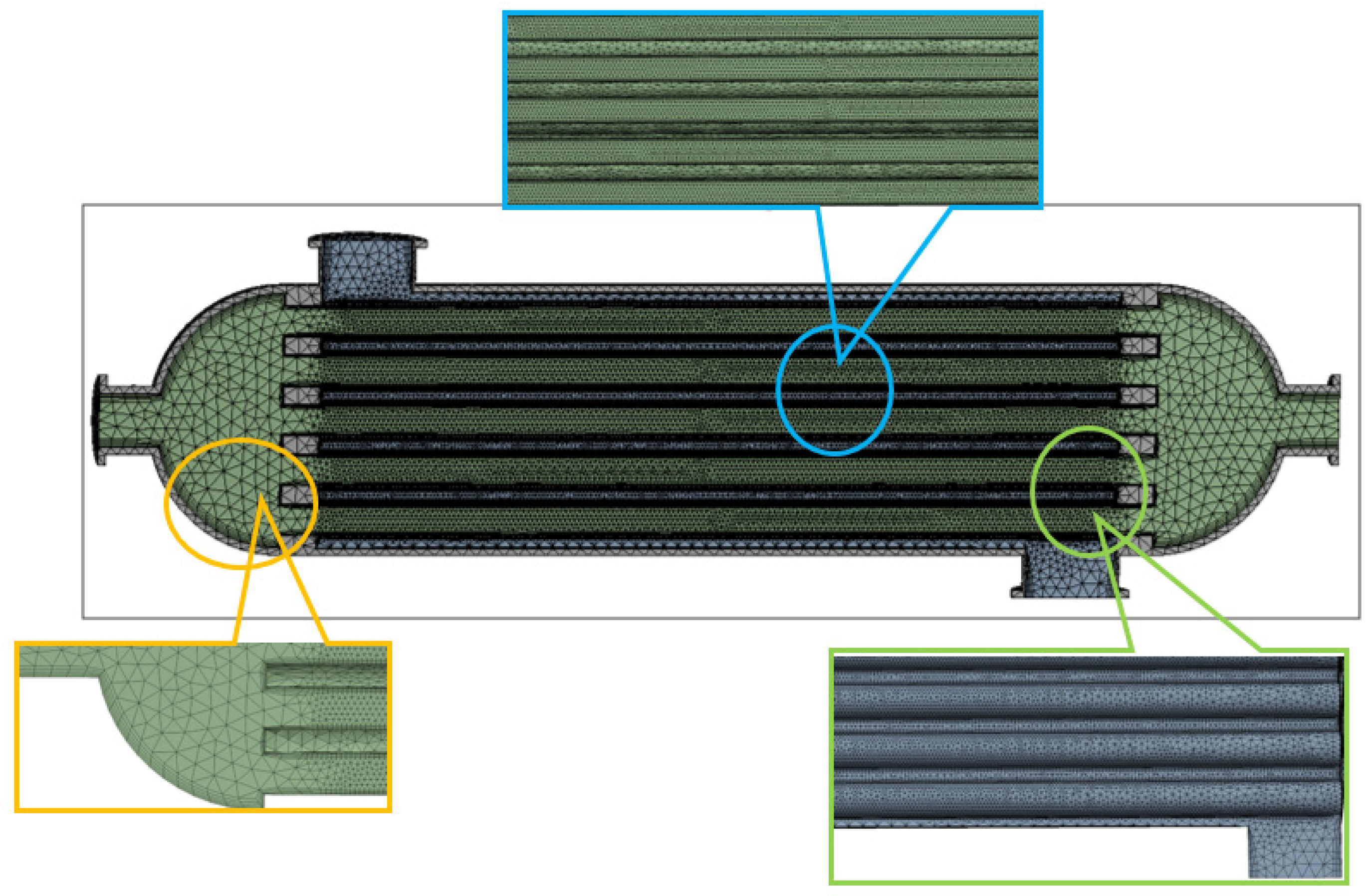


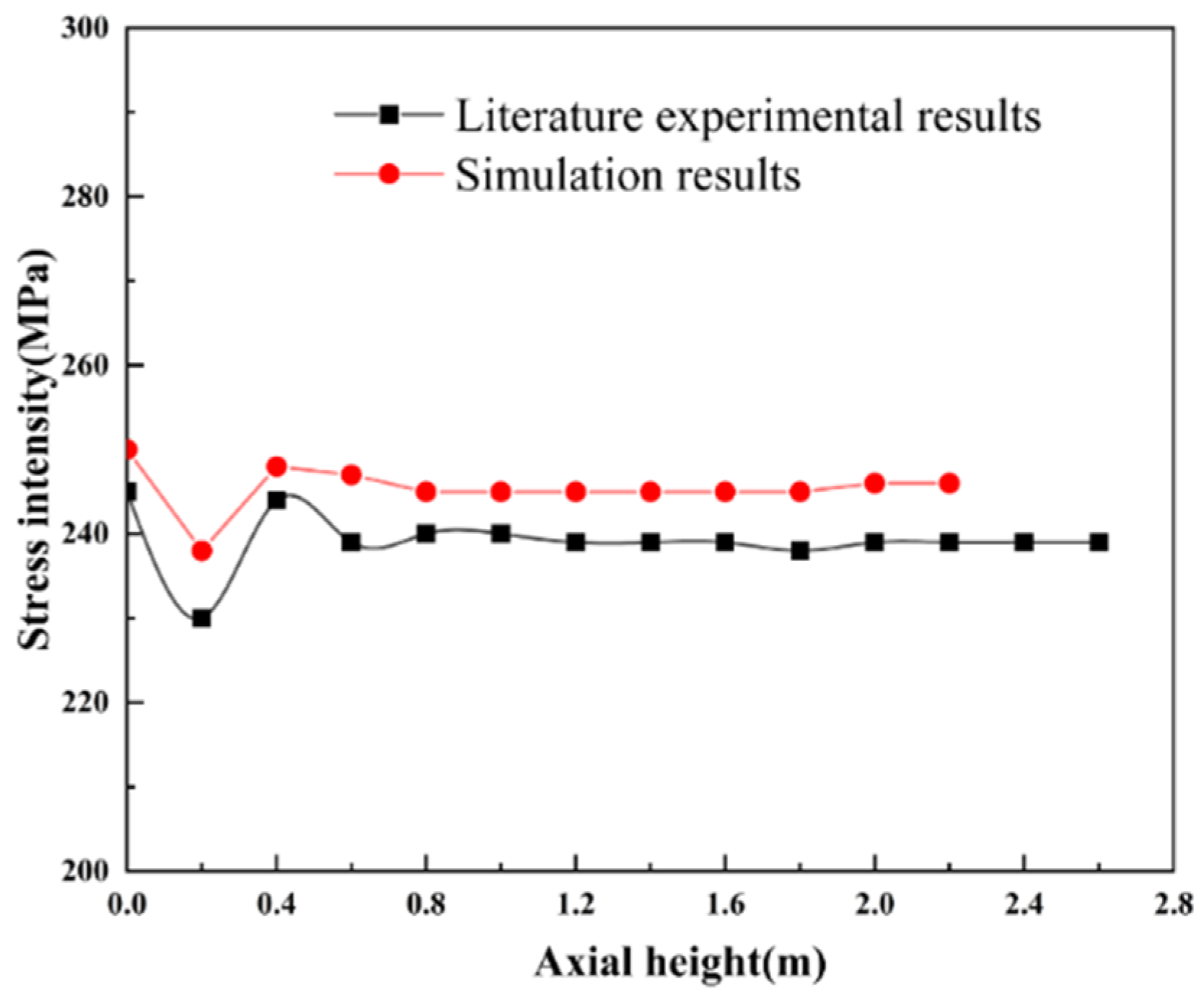




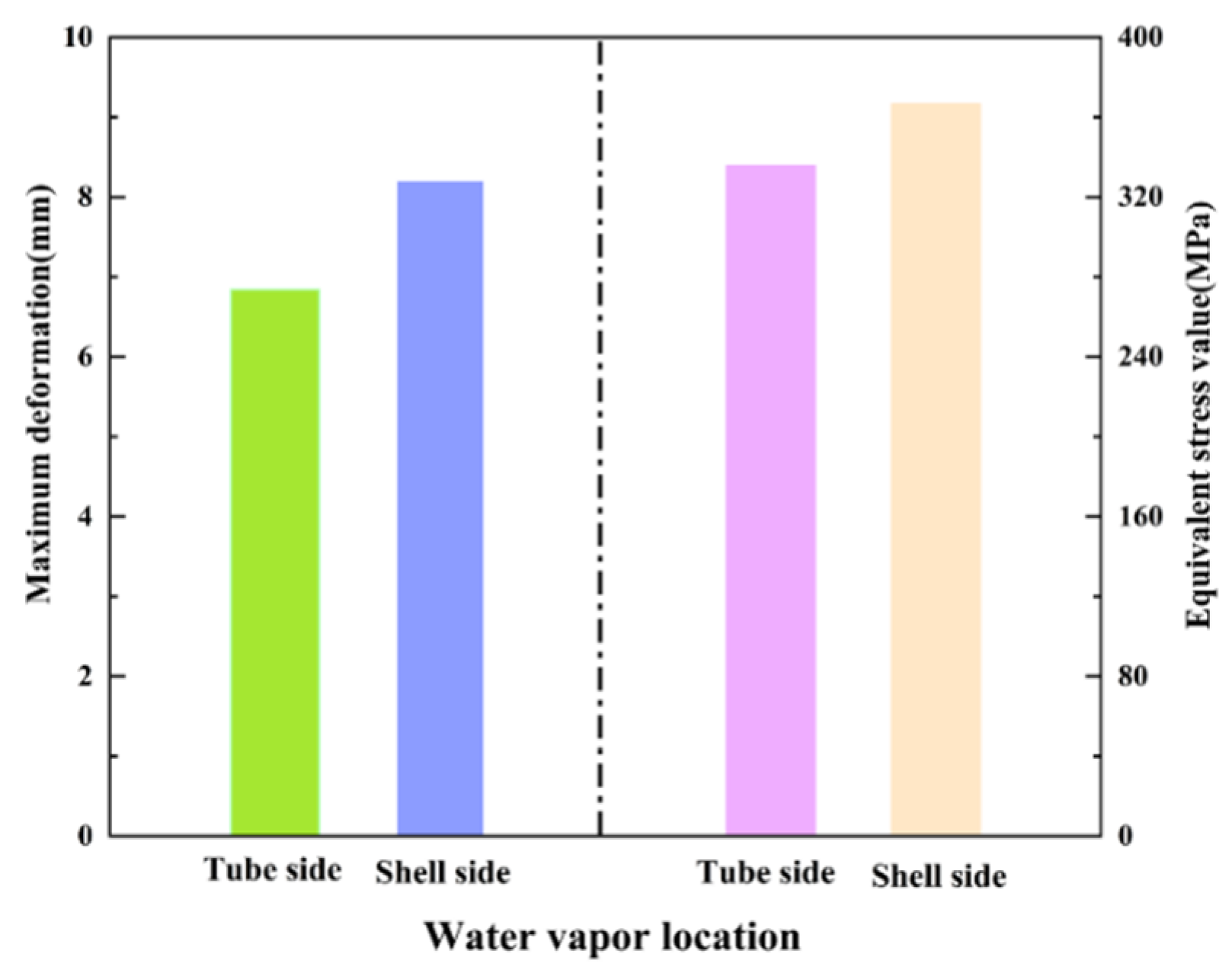




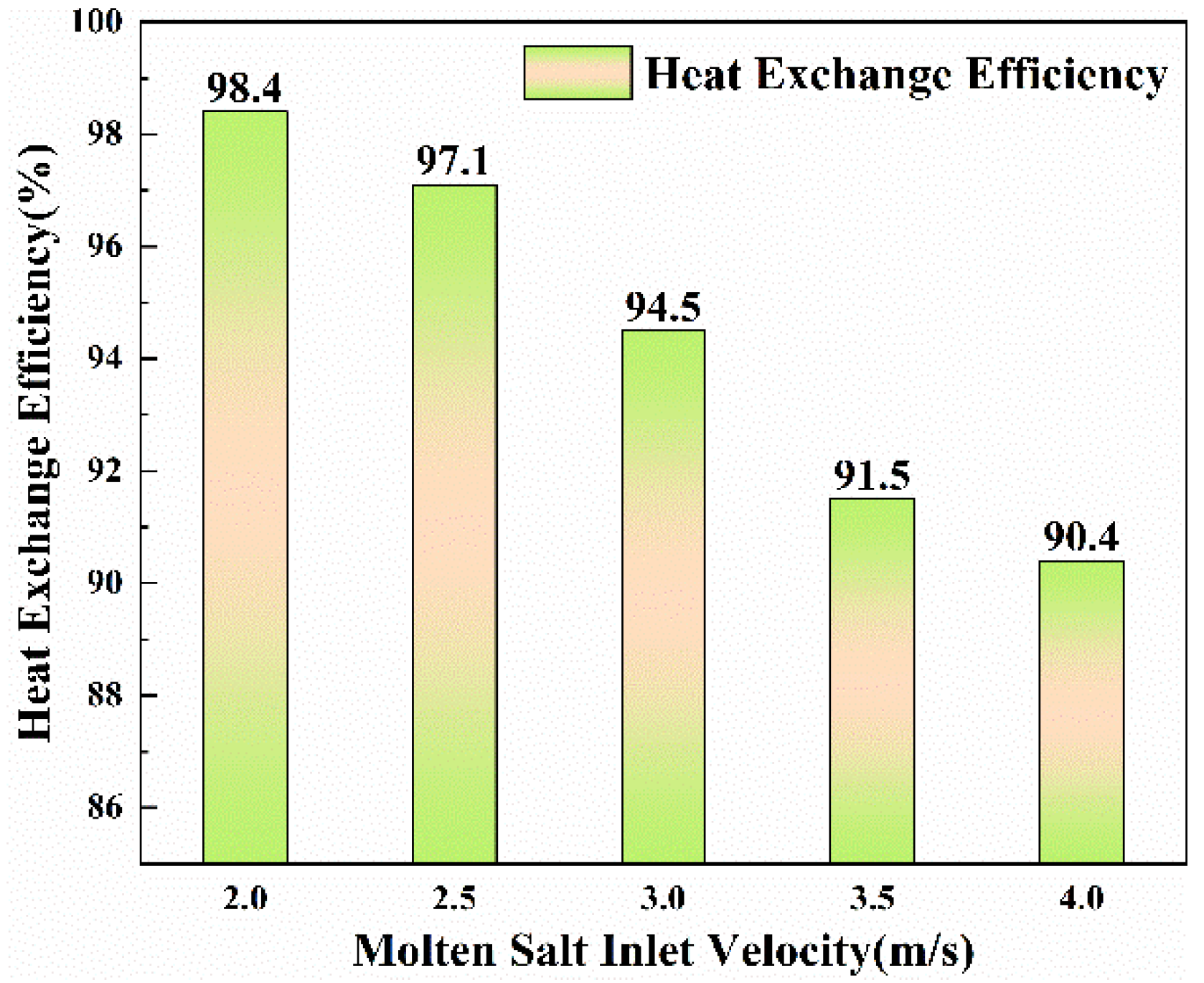
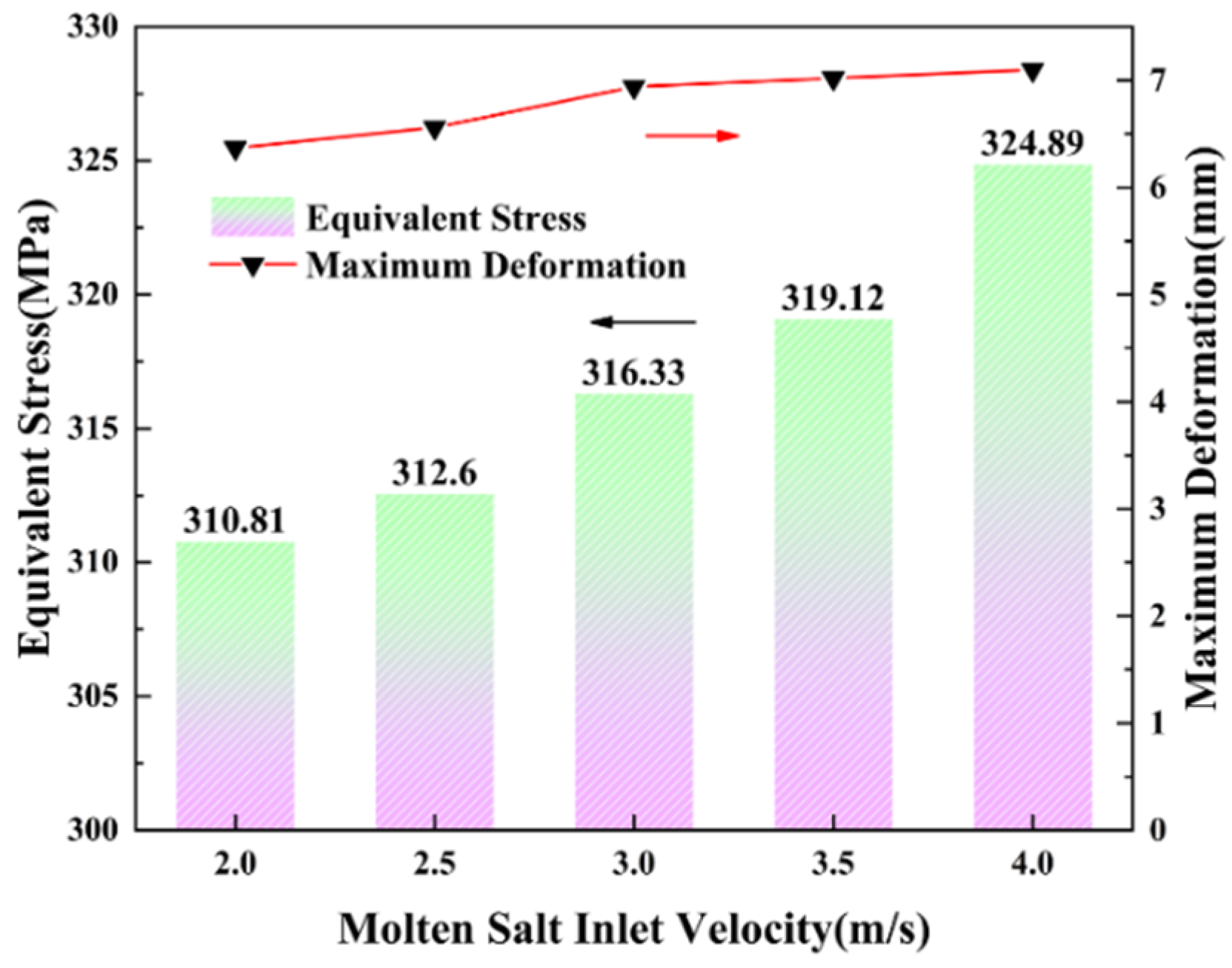
| Heat Exchanger Structure | Quantity | Length (mm) | Inside Diameter (mm) | Outer Diameter (mm) | Thickness (mm) | Width (mm) |
|---|---|---|---|---|---|---|
| Shell | 1 | 3030 | 720 | 760 | 20 | \ |
| Tube bundle | 21 | 2270 | 90 | 98 | 4 | \ |
| Tube sheet | 2 | \ | 720 | \ | 20 | \ |
| header | 2 | \ | 720 | 760 | 20 | \ |
| Pipe-side connection | 2 | 140 | 162 | 194 | 16 | \ |
| Shell-side connection | 2 | 140 | 256 | 273 | 8 | \ |
| Flange | 4 | \ | \ | \ | 10 | 40 |
| Molten Salt Physical Parameter (T/°C) | Empirical Formula |
|---|---|
| Density ρ (kg/m3) | ρ = 2085.4 − 0.6256T |
| Constant-Pressure Specific Heat Capacity cp (J/(kg·°C)) | cp = 1442.3 + 0.1736T |
| Thermal Conductivity k (W/(m·K)) | k = 0.443 + 0.00019T |
| Dynamic Viscosity μ (Pa·s) | μ = 0.2241 − 1.2 × 10−4T + 2.166 × 10−7T2 − 1.376 × 10−10T3 |
| Import Parameters | Water Vapor | Molten Salt |
|---|---|---|
| Inlet pressure (MPa) | 15.31 | 1.0 |
| Inlet temperature (°C) | 360 | 550 |
| Inlet velocity (m/s) | 25.5 | 3.5 |
| Parameter | Superheater | |
|---|---|---|
| Water Vapor Location | Tube Side | Shell Side |
| Molten salt inlet temperature (°C) | 570 | |
| Molten salt outlet temperature (°C) | 446 | 477 |
| Water vapor inlet temperature (°C) | 345 | |
| Water vapor outlet temperature (°C) | 545 | 527 |
| Heat exchange efficiency (%) | 94.2 | 86.7 |
| Equivalent stress (MPa) | 335.63 | 366.33 |
| Maximum deformation (mm) | 6.84 | 8.12 |
| Water Vapor Inlet Temperature (°C) | Water Vapor Outlet Temperature (°C) | Molten Salt Inlet Temperature (°C) | Molten Salt Outlet Temperature (°C) | Heat Transfer Efficiency (%) |
|---|---|---|---|---|
| 300 | 523 | 563 | 430 | 98.3 |
| 310 | 526 | 563 | 433 | 97.6 |
| 320 | 532 | 563 | 435 | 97.1 |
| 330 | 535 | 563 | 438 | 96.1 |
| 340 | 541 | 563 | 440 | 95.8 |
| 350 | 545 | 563 | 441 | 93.7 |
| 360 | 552 | 563 | 442 | 91.6 |
| Molten Salt Inlet Velocity (m/s) | Water Vapor Inlet Temperature (°C) | Heat Transfer Efficiency (%) | Equivalent Stress (MPa) | Maximum Deformation (mm) |
|---|---|---|---|---|
| 2.0 | 415 | 98.4 | 310.81 | 6.37 |
| 2.5 | 440 | 97.1 | 312.68 | 6.46 |
| 3.0 | 455 | 94.5 | 316.33 | 6.94 |
| 3.5 | 465 | 91.5 | 319.12 | 7.02 |
| 4.0 | 475 | 90.4 | 324.89 | 7.10 |
Publisher’s Note: MDPI stays neutral with regard to jurisdictional claims in published maps and institutional affiliations. |
© 2022 by the authors. Licensee MDPI, Basel, Switzerland. This article is an open access article distributed under the terms and conditions of the Creative Commons Attribution (CC BY) license (https://creativecommons.org/licenses/by/4.0/).
Share and Cite
Zeng, Y.; Cui, G.; Wu, W.; Xu, C.; Huang, J.; Wang, J.; Yang, Z. Numerical Simulation Study on Flow Heat Transfer and Stress Distribution of Shell-and-Tube Superheater in Molten Salt Solar Thermal Power Station. Processes 2022, 10, 1003. https://doi.org/10.3390/pr10051003
Zeng Y, Cui G, Wu W, Xu C, Huang J, Wang J, Yang Z. Numerical Simulation Study on Flow Heat Transfer and Stress Distribution of Shell-and-Tube Superheater in Molten Salt Solar Thermal Power Station. Processes. 2022; 10(5):1003. https://doi.org/10.3390/pr10051003
Chicago/Turabian StyleZeng, Yong, Guangyao Cui, Wangsong Wu, Canjun Xu, Jing Huang, Jiaming Wang, and Zhongqing Yang. 2022. "Numerical Simulation Study on Flow Heat Transfer and Stress Distribution of Shell-and-Tube Superheater in Molten Salt Solar Thermal Power Station" Processes 10, no. 5: 1003. https://doi.org/10.3390/pr10051003





